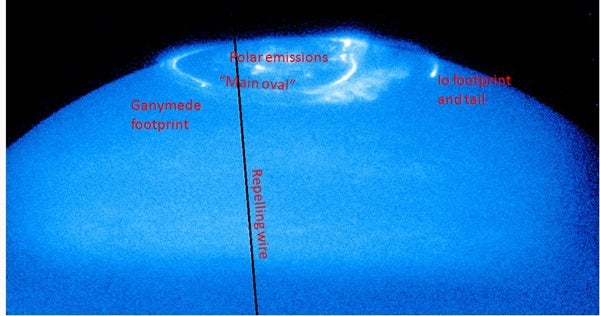Studies of features in Jupiter’s spectacular and rapidly changing aurorae have given new insights into the complex electromagnetic interactions between the giant planet and two of its innermost moons.
As Ganymede and Io orbit Jupiter, they interact with regions of plasma and generate electromagnetic waves. These waves are projected along Jupiter’s magnetic field lines toward Jupiter’s poles, where they cause auroral bright spots. Scientists from the University of Liege in Belgium have used thousands of images taken by the Hubble Space Telescope in ultraviolet wavelengths to monitor these auroral features in unprecedented detail.
“Each of these auroral structures is telling an ongoing story about vast transfers of energy taking place far away from the planet,” said astrophysicist Denis Grodent. “By analyzing the exact locations of these features and how their shape and brightness changes as Io and Ganymede move in their orbit around Jupiter, we have created the most detailed picture to date of how Jupiter and these moons are electromagnetically interconnected.”
Uniquely among Jupiter’s moons, Ganymede has a strong enough magnetic field to carve a protective magnetic bubble within Jupiter’s powerful magnetosphere. Analysis of the Hubble images by Grodent and his colleagues has allowed them to measure accurately the size of the Ganymede auroral footprint for the first time. They have found that it is too big to be a simple projection of Ganymede’s cross-section. However, using a three-dimensional computer model to map the footprint back along the field lines, the team has found that it corresponds well with the diameter of Ganymede’s mini-magnetosphere.
In addition, the sequences of Hubble images revealed unexpected brightness variations of Ganymede’s auroral footprint at three different timescales — 100 seconds, 10 to 40 minutes, and 5 hours.
“Each of these timescales appears to refer to a specific aspect of the Ganymede-Jupiter interaction and allows us to identify possible actors of this interaction,” said Grodent. “The 5-hour variation appears to be linked to the rotational period of Jupiter’s magnetic field and the movement of Ganymede through the tilted plasma sheet that surrounds the planet. The 10-40 minute variations could be due to sudden changes in energy due to plasma being injected into the system, and the 100-second pulses may be linked to bursts of magnetic energy being suddenly released when Jupiter and Ganymede’s magnetic field lines connect. However, we are not sure at this stage.”
The team has also mapped the positions of all possible locations of the auroral footprint of Jupiter’s volcanically active moon, Io, with unprecedented accuracy. Io’s footprint consists of a series of spots and a long tail that swirls out about 19,000 miles (30,000 kilometers) in the direction of the planet’s rotation. The angle of observation in some of the Hubble images has allowed the team to measure the altitude of the tail for the first time with accuracy.
“We found that the tail is at an altitude of approximately 600 miles (900 kilometers) above Jupiter’s cloud tops,” said Bertrand Bonford. “Interestingly, although the brightness of the tail decreases as it gets further away from the main spot, the altitude remains relatively constant. We also saw spectral absorption indicating that methane is present, which is unexpected at such a high altitude.”
Io’s footprint arises as a result of the moon’s motion through a doughnut-shaped torus of charged particles, which accumulates along Io’s orbit from material ejected by its volcanoes. In this flow of particles, Io acts as a boulder in a stream, generating powerful waves that propagate toward Jupiter’s poles. These waves have the special property to project electrons in both directions along the magnetic field lines. When these electrons finally hit Jupiter’s atmosphere, they create aurora in the form of luminous spots. In addition, Io drags on the plasma, briefly slowing it down. When the plasma is reaccelerated to normal speed, it generates electric currents that form the tail.
The team’s analysis shows that the charged particles that generate Io’s auroral features have a wide range of energies, meaning some electrons penetrate deep into the atmosphere while others lose most of their energy in the upper atmosphere.










